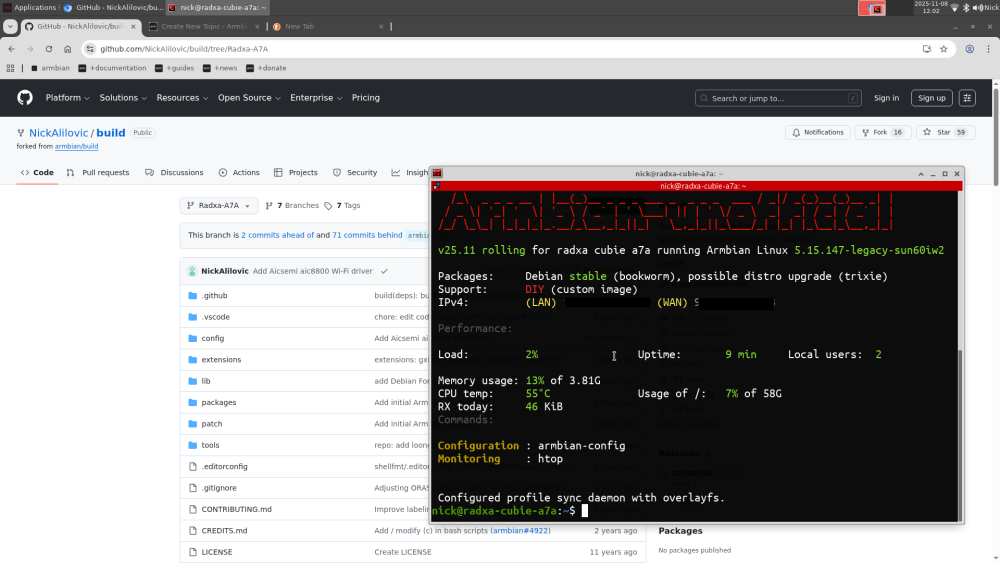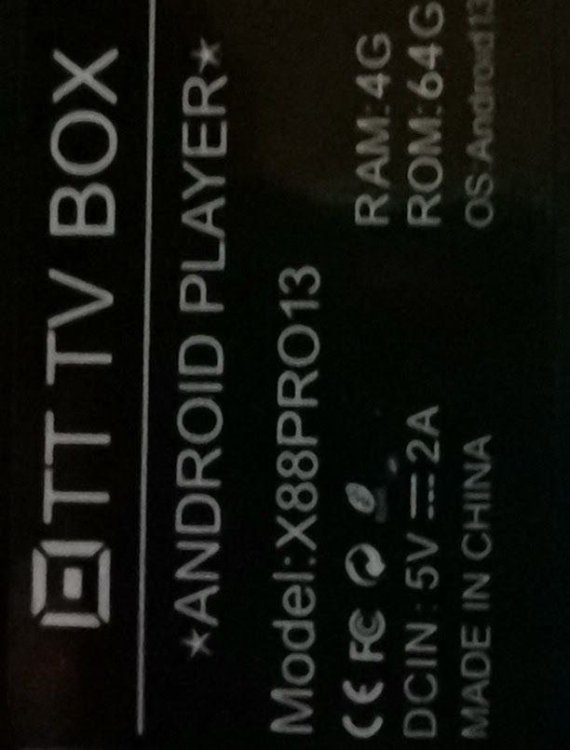All Activity
- Past hour
-
In the end, I couldn’t recover the device and ended up purchasing a new one. It was also a V5.1 board, but fortunately, it booted from the SD card without any extra steps and installed successfully. It seems we should keep in mind that even boards with the same version may not always work the same way.
-
There are schematics available for this device, so one could get a hint from those, but depends if you have electronics background or not. To me it seems that higher level software in Debian/Linux enables power management handling all the way using info it gets from the power management chip/circuitry. You can guess that for this device, same as smartphone, battery operation is considered primary/essential, so decision is 'low-batt' and shutdown. I have a BananaPi M1 that also has LiPo charging, but that is DIY soldereing, so no OS component bothers with not-connected cell, but if a cell is connected/soldered which I did, is charges and runs on that cell if microUSB PSU (they call it 'AC' in the chip signal names) is disconnected, although its SATA port is unpowered then. Runs Armbian Trixie CLI only (eth + serial console). An old business HP 2-core laptop that I got without battery and HDD runs fine on just the original HP power adaptor (has 3rd wire for some genuine HP charger purposes). For USB-C powered devices, there might be many things to deal with, e.g. my ROCK5B after un-boxing goes in a bootloop with a RPI5 PSU, was/is know, so I feed it with own 12V USB-C pig-tail. For the Pinebook, it might be that the 5V is perfectly 5.000V but drops to 4.900V or so in spikes under load, so the typical 5V SBC powering issue well-known from RPi and other cheap SBCs that cannot handle >5V USB PD voltages. The Pinebook might do well if you fake the battery, so look at colored wire/connector. I have used that several times in the past decades. The yellow wire might be for temperature so besides a proper voltage on black and red, you also need to do something with the yellow wire I guess. It also might be that is you skip/disable the parts of software that do power management handling, that it runs fine. So I would boot/run the 'image' of the pinebook in a systemd-nspawn container or libvirt VM (at least the user space) and see what is what. Maybe it is something like purge 'laptop-tools' package or so, or blacklist the kernel module for power management.
- Today
-
Yes, but I haven't test it. I used pre-flashed to boot my image and I am done with this board / platform. Someone else has to take it from here. If board gets maintained status, this will start working automatically. Links point to our servers where this board images are not present - we only keep supported on our servers, for things we know they at least boot.
-
The rk3588 soc has a fixed boot order which is spi, emmc, microsd, other I think. So if there is a boot loader found on spi it will ignore other options and try to boot from that. While Armbian uboot binaries on spi are instructed to check if there is a microsd card inserted and boot from that, vendors can (ab)use this circumstance to make it harder for other operation systems being used because tools like rkdevtool are necessary to get rid of it. If the spi is pre-flashed with crap, I guess that's why the step is necessary.
-
😄
-
I believe it was android I don't care what os it has just want to get it to work again
-

mxq pro 4k 5g allwinner h313 can't sd card boot
Ducdanh Nguyen replied to Ducdanh Nguyen's topic in Allwinner CPU Boxes
@AndroidNewbie Do you have the image of the box? -
Could you please explain why we need to erase and flash bootloader again? Could you elaborate the reason behind this step?
-
Hey @Igor, is there new bootloader firmware built as a result of your changes? I can probably do a quick test at some point (I've got a large build underway on one of my devices). This page is probably in need of work: https://www.armbian.com/espressobin/ the download links don't seem to work for me (they redirect to mirrors.aliyun.com)
-

mxq pro 4k 5g allwinner h313 can't sd card boot
AndroidNewbie replied to Ducdanh Nguyen's topic in Allwinner CPU Boxes
hello everyone!! I have the same box here, it's says that it's 8gb 128gb, but real specs is 1gb of ram and 8gb of rom, any help? Thanks! - Yesterday
-
Hi, I’m working on enabling I²S audio output using a PCM5102 DAC on an Orange Pi Zero 2W (SoC: Allwinner H618) running Armbian_community_25.11.0-trunk.334_trixie_current_6.12.47_minimal. Despite several tests and rebuild attempts, I haven’t been able to obtain any sound output from the I²S interface. Below is a summary of what has been done so far. Hardware setup Board: Orange Pi Zero 2W SoC: Allwinner H618 DAC: PCM5102 (I²S input, analog stereo output) Connections: I2S0 → used for DAC (pins LRCK, BCLK, DIN, GND, 3.3V) Confirmed pin mappings according to H618 documentation and available DTS files. OS Image: Armbian_community_25.11.0-trunk.334_Orangepizero2w_trixie_current_6.12.47_minimal What has been done 1. Kernel confirmed to be mainline-based (6.12.47-current-sunxi64). Linux orangepizero2w 6.12.47-current-sunxi64 #1 SMP aarch64 GNU/Linux 2. Checked kernel symbols to verify presence of sunxi audio modules: Shows sound/soc/sunxi/sun8i-codec.c among others. Created a custom overlay at /boot/overlay-user/sun50i-h618-i2s0-pcm5102.dtso, based on examples from sun8i boards, with simple-audio-card referencing the i2s0 controller. Enabled overlay in /boot/armbianEnv.txt : user_overlays=sun50i-h618-i2s0-pcm5102 Rebooted and verified device tree loading → No audio device or sound card is registered. Also tried with predefined overlay sun50i-h618-i2s2-pcm5102 included in the Armbian tree → no sound card detected (aplay -l returns “no soundcards found”). Findings It seems that the H618 SoC has no upstream audio codec driver (unlike H616 which includes sun8i-codec). The I²S controller node exists in the mainline kernel sources, but may not be fully supported or linked to a DAI (Digital Audio Interface) for external DACs. simple-audio-card bindings appear to compile correctly in the overlay, but the device never registers in ALSA. Questions Is there any working DTS overlay or patch enabling I²S output (no internal codec) for the H618 platform? If not, what would be the correct approach — patching the DTS at kernel source level or adding a compatible binding manually? Has anyone successfully used a PCM5102 (or similar DAC) with the H618-based boards under Armbian? My goal To have a functional stereo I²S audio output through PCM5102 (or any compatible DAC), recognized as an ALSA sound card in Linux. Any help, hints, or working overlay examples would be greatly appreciated. Thanks in advance for your time and expertise! Jose Cardoso
-

How to install armbian in h618?
Алексей Торопов replied to alienxz77b's topic in Allwinner CPU Boxes
Please help, I'm stucked (or, may be stupid). I use my tv-box as printserver (Klipper), it works fine. Now I attempt to use accelerometer ADXL345 usb board, and I havnt success. It must be simple task, but something went wrong here. Board works, flashed normally without any errors and shown as should by lsusb: klipper@transpeed-8k618-t:/usr/lib/udev/rules.d$ lsusb Bus 003 Device 002: ID 1a86:7523 QinHeng Electronics CH340 serial converter Bus 003 Device 001: ID 1d6b:0001 Linux Foundation 1.1 root hub Bus 002 Device 001: ID 1d6b:0002 Linux Foundation 2.0 root hub Bus 004 Device 013: ID 1d50:614e OpenMoko, Inc. rp2040 Bus 004 Device 001: ID 1d6b:0001 Linux Foundation 1.1 root hub Bus 001 Device 001: ID 1d6b:0002 Linux Foundation 2.0 root hub Also, it must be appear as serial device, but... klipper@transpeed-8k618-t:/usr/lib/udev/rules.d$ ls -l /dev/serial/by-id total 0 lrwxrwxrwx 1 root root 13 Nov 8 18:47 usb-1a86_USB_Serial-if00-port0 -> ../../ttyUSB0 ...here is my "Ender" only. dmesg: [30617.149526] usb 4-1: new full-speed USB device number 22 using ohci-platform [30617.358206] usb 4-1: New USB device found, idVendor=1d50, idProduct=6177, bcdDevice= 1.00 [30617.358227] usb 4-1: New USB device strings: Mfr=1, Product=2, SerialNumber=3 [30617.358235] usb 4-1: Product: rp2040 [30617.358242] usb 4-1: Manufacturer: katapult [30617.358249] usb 4-1: SerialNumber: E6647C7403433637 [30663.467079] usb 3-1: new full-speed USB device number 3 using ohci-platform [30663.665820] usb 3-1: New USB device found, idVendor=1a86, idProduct=7523, bcdDevice= 2.64 [30663.665867] usb 3-1: New USB device strings: Mfr=0, Product=2, SerialNumber=0 [30663.665891] usb 3-1: Product: USB Serial [30663.668223] ch341 3-1:1.0: ch341-uart converter detected [30663.680198] usb 3-1: ch341-uart converter now attached to ttyUSB0 I've search solutions, but have not resolve. -
@eli It's compiled in the kernel https://github.com/NickAlilovic/build/blob/Radxa-A7A/config/kernel/linux-sun60i-legacy.config#L1659-L1672
-
Thanks, is KVM supported?
-
Problems - nothing much: - rk3588 vendor performance and video encoding possibility (could be userspace related - we don't know atm) - hdmi input eating irq / high load - several boards are stuck with vendor boot loader which has troubles compiling with modern compiler - atf has been bumped and might have effects on boards that are using it - suspend will be disabled by default on systemd level
-
I gave some information ..... Hit:8 http://fi.mirror.armbian.de/beta bookworm InRelease ? 🙂
-
For those with a Radxa Cubie A7A, I made a custom Armbian Build using the BSP kernel. The framebuffer console doesn't work right now. So you will need a usb serial device for user setup. After that HDMI works fine. https://github.com/NickAlilovic/build/tree/Radxa-A7A https://github.com/NickAlilovic/build/releases/tag/Radxa-a7a-v0.1
-

Setup for current Armbian/Ubuntu (25.8.2) for PCF8563 RTC on C2
Scott Ksander replied to Scott Ksander's topic in Odroid C2
I tried rebuilding the Device Tree as suggested in other forums. No Joy!! Still can't get it to work. Also added i2c-dev module but that isn't showing in lsmod. Help appreciated. Clearly I am missing something here. This shouldn't be difficult. :-) -
Apparently, there are more versions of the box. One has two stars on the nameplate and "V 1.4" printed on the PCB. Although WiFi works on version 1.2, if does not work on this version V1.4 has a different Wi-Fi chip: EA6521. dmesg | grep 'SDIO' gives: [ 9.621165] mmc2: new ultra high speed SDR104 SDIO card at address 8800
-
https://paste.armbian.com/qocicuyote.yaml <-- captured from debug UART Brand new odroid-m1, Samsung Pro Endurance 256GB; and a brand-new/uninitialized Samsung PM9A1 256GB NVMe. It drops me to a shell [presumably the initramfs]. Note: I'm not out of options yet, I can try building my own image with newer current or edge kernels. Edited to add: I think it's booting me to the petitboot env, not even attempting to boot the SD card,
-
> drop them. > drop it. sorry. Someone is dropping something here I'm not sure if support was ever better or downgraded at one point because it never had it's own page on the site, it's just a mention of a device tree file swap under orange pi 5, which is listed as standard. If it's not different enough to warrant it's own page, it's entirely reasonable to think it is supported as much as the orange pi 5, under which it can be found. The max, plus and pro variants all have their own pages. 🤷♂️ I do understand how tooling works, as I've spend enormous amounts of time digging through the repo and modifying it. Mix and matching patches, modules, or loaders from other projects where their stuff works , and armbian's doesnt or visa versa, to get full functionality images across for the 6 different sbcs I've got. Often times certain projects will have things like vpu figured out way before other projects.
-
@emor acid The build system downloads the original uboot and kernel sources. Then it applies the patches on top. Whatever you edited will be erased. The only way around this is to create a patch with your changes. You could use dtc to compile your dts file into a binary dtb. Then copy it into your sdcard.












